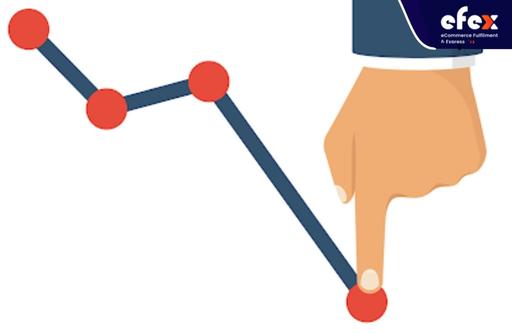
More Helpful Content
The list of problems that negatively affect the sales of a business cannot be complete without the cost of lost sales. The cost of lost revenue is a problem that many businesses have. Without the right strategies to minimize it, you will lose customers, affecting revenue and the image of your business.
So understanding the definition and importance of dealing with the cost of lost revenue is important to help improve a company's quality. This information will be discussed in the article below.

Cost of lost sale refers to the amount of money that is lost when the business fails to meet the purchasing needs of customers. To calculate the lost cost of sales for a particular item, we multiply the annual sales potential (the amount of sales that would be received if a sufficient number of products were supplied to the market) multiplied by the sales. enterprises can not meet due to shortage of products or raw materials for production.
LSC = USP x FAD x SF x (1 - UFR)
For example, if unit price is $1.00, demand for a product is 800 units, fill rate is 85%, and shortfall is 30%, then the item's lost cost of sales will is calculated as follows: LSC = 800 units/year x $1.00/unit x (1 - 0.85) x 0.3 = $36/year
- Read More: Order Management System: Definition, Process And Value
- Read More: Order management system for Ecommerce: Definition, Key Effect, Benefit
Lost sales is an issue that any retailer or business wants to minimize as much as possible. Because without strategies and opportunities to address it, lost sales will bring the following disadvantages:

The cause of the drop in sales is not only an inefficient supply chain, but it is also due to a number of other reasons. For example, after the cycle of selling a popular product has ended, businesses will invest and import raw materials to carry out the production of a new product. This means lower profit margins. Newly sold products can be sold out and thus make a return for the money invested.
However, there are also cases where the goods produced are not sold out, leading to losses and the business has to bear higher costs. Likewise, unsold products become dead inventory. This increases unnecessary capital. The company will lose money that would otherwise have been invested and now have to bear the costs of unsold products. The inefficiencies in allocating invested funds negatively affect the entire system.
👉 Read More: Excess Inventory: Definition, Disadvantages And How To Reduce
Excessive discounts on unsold items will affect the sales of other products as buyers will haggle and prioritize lower-priced products instead of popular items as before. In the long run, the brand value of the business also decreases if there are many discounts, it makes users see inefficiencies in the way the company operates.
Therefore, supply chain decisions need to be made in a critical and calculated manner based on assumptions about the quantity and selling price of products.
Sustainability in the production of products is being emphasized more than ever. The reason for this is that customers are increasingly interested in the sustainability of the business. Customers are willing to pay higher prices for sustainably produced products.
On the contrary, news about the unsustainability of a business will cause long-term damage to their business. There are many ways that businesses are adopting to improve business sustainability, the simplest ways are probably reducing the cost of lost sales. When market demand suddenly increases, businesses will have to quickly replenish and transport goods from the place of production.
Even when transporting goods from one store to another to meet demand, this also increases the amount when released into the environment. Lost sales related to manufactured inventory are judged to be worse for the environment. All the materials and energy used to produce them are lost when they are disposed of.
👉 Read More: LIFO – FIFO Inventory Cost Method: How To Calculate And Example
Although some businesses have tried to come up with innovative ways to recycle or reuse products that cannot be sold, most of it still ends up as waste. Users also understand this and the movement to push back on wasteful retail activities is also gradually being promoted, especially for the fashion and grocery industry. You will not be able to convince your customers of the sustainability of your business without strategies that effectively address the problem of lost revenue.
In general, cost of lost sales will have a negative impact on the environment, generate a lot of waste and especially damage the reputation of the business.

As e-commerce grows, it also helps customers to increase access to more product suppliers. Therefore, to attract the attention of customers, businesses must improve customer service. Customer service is excellent at anticipating and responding to customers' needs even before they realize what their needs are.
If you offer products that don't attract customers or are out of stock, it means you don't understand what they want. And this leaves customers with no reason to be loyal to you, and it's understandable that they'll find a competitor with better customer service to shop with.
👉 Read More: Just-in-time Inventory (JIT): How It Works And Its Advantages
Sold inventory and unsold inventory may seem different, but they are not. Because if you do not understand what the customer wants. In the long run, the result will return to the same result: customers no longer buy from you and the commercial market share shrinks.
All businesses are trying to come up with ways to minimize the cost of lost sales. But this is by no means simple. Understanding what your customers want and delivering it at the right time would be impossible without investing a lot of money and time into market research and analysis.
In this regard, not all businesses are eligible to pay. These have been somewhat simplified with the help of modern software devices that are able to quickly and accurately analyze customer behavior.
So if you have enough data and know how to make the most of this resource, you can reduce the cost of lost sales. If you are not serious about this, there is no way to reduce lost sales and it will also leave you behind.
There will be no happy ending for a business model that is less competitive in the market and does not satisfy the target customer.
👉 Read More: Real-Time Inventory Management: How It Works And Benefits
Overall, reducing the cost of lost sales is not easy, but not impossible. This requires business owners to have strategies based on market data analyzed by the support of technology equipment to have reasonable business plans. Producing products that meet customer needs will be the most effective and simple way to reduce the cost of lost sales. Hope you have a good time with Efex.


